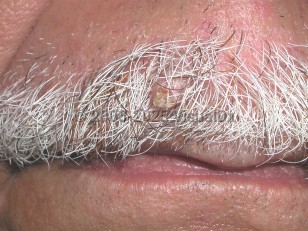Trichilemmoma in Adult
Alerts and Notices
Important News & Links
Synopsis

Trichilemmoma is a benign follicular tumor with differentiation toward the outer root sheath of the hair follicle. Patients may present with an individual papule or they may have multiple skin-colored papules that tend to localize to the central face. Although most commonly found on this location, any nonglabrous site may be affected. Genital lesions may also occur, and they can mimic condylomata.
Although the origin is not entirely understood, trichilemmomas often harbor an HRAS mutation supporting a neoplastic etiology. However, others have suggested a viral (human papillomavirus) origin, but studies thus far have been conflicting.
Solitary trichilemmomas are relatively common in older adults, have no sex predilection, and are asymptomatic.
If multiple trichilemmomas are present in context of other cutaneous findings and certain malignancies, then the diagnosis of Cowden syndrome should be considered. Cowden syndrome, or multiple hamartoma syndrome, is an autosomal dominant disease resulting from mutations in the PTEN gene. It is associated with cancers of the gastrointestinal tract, thyroid, and breast. Mucocutaneous manifestations include acral keratoses, palmoplantar keratoses, papillomatous lesions, sclerotic fibromas, and mucosal cobblestoning.
A variant of trichilemmoma is the desmoplastic trichilemmoma. This presents as a <1-cm papule or nodule on the face (most commonly on the lip), neck, scalp, or chest. It is sometimes found within a nevus sebaceus. It is not associated with Cowden disease.
Trichilemmal carcinoma occurs as a solitary nodular, polypoid, or exophytic growth on the sun-exposed skin of older patients. Clinically, it is a nonaggressive tumor and has limited metastatic potential.
Immunocompromised patient considerations: Immunocompromised patients are at risk for the development of trichilemmal carcinoma.
Although the origin is not entirely understood, trichilemmomas often harbor an HRAS mutation supporting a neoplastic etiology. However, others have suggested a viral (human papillomavirus) origin, but studies thus far have been conflicting.
Solitary trichilemmomas are relatively common in older adults, have no sex predilection, and are asymptomatic.
If multiple trichilemmomas are present in context of other cutaneous findings and certain malignancies, then the diagnosis of Cowden syndrome should be considered. Cowden syndrome, or multiple hamartoma syndrome, is an autosomal dominant disease resulting from mutations in the PTEN gene. It is associated with cancers of the gastrointestinal tract, thyroid, and breast. Mucocutaneous manifestations include acral keratoses, palmoplantar keratoses, papillomatous lesions, sclerotic fibromas, and mucosal cobblestoning.
A variant of trichilemmoma is the desmoplastic trichilemmoma. This presents as a <1-cm papule or nodule on the face (most commonly on the lip), neck, scalp, or chest. It is sometimes found within a nevus sebaceus. It is not associated with Cowden disease.
Trichilemmal carcinoma occurs as a solitary nodular, polypoid, or exophytic growth on the sun-exposed skin of older patients. Clinically, it is a nonaggressive tumor and has limited metastatic potential.
Immunocompromised patient considerations: Immunocompromised patients are at risk for the development of trichilemmal carcinoma.
Codes
ICD10CM:
D23.30 – Other benign neoplasm of skin of unspecified part of face
SNOMEDCT:
274900003 – Trichilemmoma
D23.30 – Other benign neoplasm of skin of unspecified part of face
SNOMEDCT:
274900003 – Trichilemmoma
Look For
Subscription Required
Diagnostic Pearls
Subscription Required
Differential Diagnosis & Pitfalls

To perform a comparison, select diagnoses from the classic differential
Subscription Required
Best Tests
Subscription Required
Management Pearls
Subscription Required
Therapy
Subscription Required
References
Subscription Required
Last Reviewed:07/19/2017
Last Updated:09/27/2021
Last Updated:09/27/2021
Trichilemmoma in Adult

